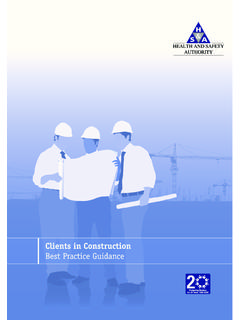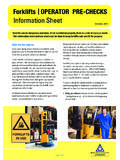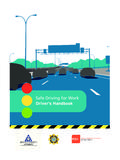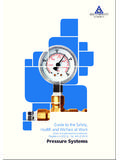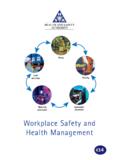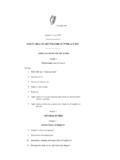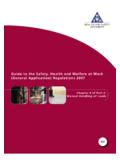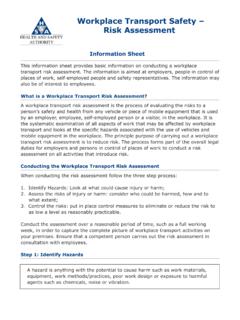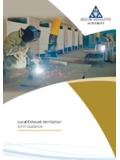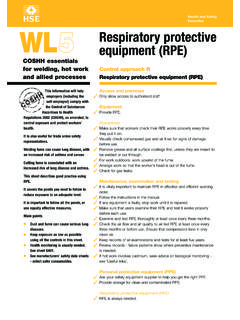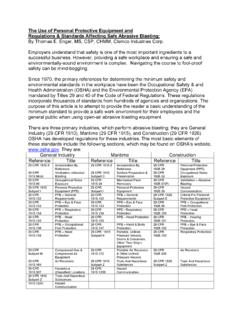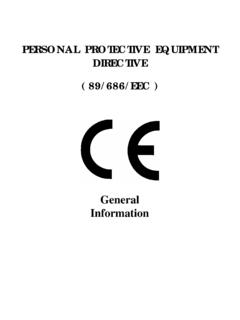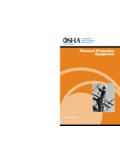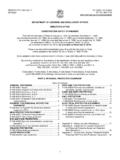Transcription of A Guide to Respiratory Protective Equipment
1 A Guide to Respiratory Protective Equipment Our vision: A national culture where all commit to safe and healthy workplaces and the safe and sustainable management of chemicals A Guide to Respiratory Protective Equipment Introduction 2. Contents Who are these guidelines for? 2. What is RPE? 2. Abbreviations Used 3. What am I legally obliged to do? 4. Standards 4. Types of Respiratory Protective Equipment 5. Selection of Respiratory Protective Equipment 6. Filters 7. Filter Types 7. Protection Factors 9. Facepiece Fit Testing 10. Qualitative fit testing 10. Quantitative fit testing 10. Conducting Fit Testing 11. Repeat Fit Testing 11. Misuse of RPE 11. Training and Records 12. Training 12. Records 12. Storage and Maintenance 12. Storage 12. Maintenance 12. Pre-Use Checks 12. References and Further Information 13. Appendicies 14. Appendix 1:Checklist for Respiratory Protective Equipment 14.
2 Appendix 2: Sample RPE Testing Programme Template 15. Appendix 3: European Standards 15. Appendix 4: List of Relevant Legislation 16. Appendix 5: RPE Sign 16. Photographs provided courtesy of TSI, Scott Health and Safety and 3M. Published in 2010 by the Health and Safety Authority, The Metropolitan Building, James Joyce Street, Dublin 1. Introduction What is RPE? Respiratory Protective Equipment (RPE) not worn Respiratory Protective Equipment (RPE) is a or selected appropriately is totally ineffective and particular type of Personal Protective Equipment may give the user a false sense of protection. (PPE), used to protect the individual wearer against inhalation of hazardous substances in the workplace The aim of these guidelines is to provide basic air. RPE should only be used where adequate control information and general guidance on the selection, of exposure cannot be achieved by other means, in use and maintenance of Respiratory protection in the other words, as a last resort on the hierarchy of workplace.
3 The guidelines predominantly provide control measures (see figure 1). Employers are advice in relation to respirators; further specialist required to firstly attempt to eliminate the hazard at advice should be sought for breathing apparatus source. RPE should only be used after all other types, in consultation with a qualified Occupational reasonably practicable control measures have been Hygienist or appropriate Health and Safety taken. PPE is considered a last resort because it only Professional. protects individual workers, is prone to failure or misuse, such as wearing the wrong RPE for the job, These guidelines are not intended to be a legal and employees wearing RPE may get a false sense interpretation of Chapter 3 of Part 2 of the Safety, of security when using RPE. Health and Welfare at Work (General Application). Regulations, 2007 ( No.)
4 299 of 2007). Who are these guidelines for? These guidelines are for employers, employees and those responsible for health and safety in the workplace, in small to medium sized businesses in particular. They are designed to give practical advice to protect the health and safety of employees through the use of Respiratory Protection. The main topics covered will be the selection, fit testing, use and maintenance of RPE. of process Elimination Substitution replacement of substance X with substance Y which is less hazardous Engineering installation of local exhaust ventilation unit Controls Administrative access controlled to work area Controls PPE use of half mask respirator, as a last resort Figure 1: The Hierarchy of Controls Page 2. A Guide to Respiratory Protective Equipment Abbreviations Used APF Assigned Protection Factor BA Breathing Apparatus CE Conformite Europeene FFP Filtering Facepiece- number indicates filter type FF Fit Factor HEPA High Efficiency Particulate Air NPF Nominal Protection Factor PAPR Powered Air Purifying Respirator RPD Respiratory Protective Device RPE Respiratory Protective Equipment PPE Personal Protective Equipment SCBA Self Contained Breathing Apparatus WPF Workplace Protection Factor Page 3.
5 What am I legally Employees' duties obliged to do? Section 13 of the Safety, Health and Welfare at Work Act, 2005 places a duty on employees, having regard The Safety Health and Welfare at Work Act, 2005 ( to their training and instructions to make correct use No 10 of 2005) requires the provision of a safe place of PPE. of work; this applies to employees, employers and the self employed. Section 19 of the Safety, Health Employees should: and Welfare at Work Act 2005, requires that employers and those who control workplaces to any Use RPE properly whenever it is required to extent must identify the hazards in the workplaces be used under their control and assess the risks to safety and health at work presented by these hazards. The results of any risk assessments should be written Report any defects in or damage to the RPE. into the safety statement.
6 Immediately Participate in any training or instruction provided on RPE. Employers' duties Inform their employer of any medical conditions Legislation relating to RPE is contained in Chapter 3 they have that might be affected by the use of of Part 2: Personal Protective Equipment of the the RPE provided to them Safety, Health and Welfare at Work (General Application) Regulations, 2007 ( No 299 of 2007). Ensure that RPE provided for their use is returned to storage after use These regulations require the provision and assessment of PPE in the workplace. Employers shall determine the conditions of use of PPE, in particular, assess the adequacy of PPE selected. An employer shall ensure that the use of an item of PPE. Standards provided is normally confined to one employee. European harmonised standards for Respiratory Where it is necessary for RPE to be used by more than one employee, arrangements should be made Protective Equipment have been developed as a by the employer to have RPE cleaned and disinfected means of demonstrating Equipment conformity with before use by another individual.
7 The basic health and safety requirements of the EC. Personal Protective Equipment Directive Personal Protective Equipment is required to be maintained and replaced appropriately. An employer (89/686/EEC). This directive is implemented in must provide information, training and instruction Ireland as the European Communities (Personal for all PPE provided for use by an employee. The Protective Equipment ) Regulations, 1993. employer is also obliged to ensure that there is adequate supervision provided. The RPE must be Only Equipment which meets these requirements is provided without charge. entitled to carry the mark and be sold for use in the EC. The numerous European Norm (EN). Schedule 2, Part A, to the Safety Health and Welfare at Work (General Application) Regulations, 2007 ( standards contain design, marking and performance No 299 of 2007) provides a non-exhaustive list of requirements for manufacturers of the different activities which may require provision of RPE.
8 Types of Equipment , a list is detailed in Appendix 4, certain standards also give guidance on usage and In relation to mandatory signage required for RPE, Schedule 9 to the Safety, Health and Welfare at Work selection, such as EN 529. (General Application) Regulations 2007 ( No. 299. of 2007) sets out the requirements for safety signs which must be used at all workplaces when hazards cannot be avoided or adequately reduced (see Appendix 5). Page 4. A Guide to Respiratory Protective Equipment Types of Respiratory Breathing Apparatus (BA) types (positive respirators). Protective Equipment A range of different types exist, fresh air hose, There are two types of RPE that are commonly used airline, and demand valve; use an independent in the workplace, either filtering devices or breathing supply of breathing quality air, for example an air apparatus device types (see figure 2).
9 Cylinder or compressor. Powered air purifying respirators, supplied air and self containing breathing apparatus are all positive pressure Filtering device types (negative respirators) devices. The pressure on the inside of the Respiratory inlet exceeds the ambient air pressure outside the A range of different types exist, dust masks, half respirator. As a general rule, positive pressure mask respirators, full face mask respirators and devices are used for more hazardous exposures. powered (fan assisted) respirators. These use filters to remove the contaminants in the workplace air. In Surgical masks are not considered RPE. Nuisance a negative pressure device one or more air purifying dust masks are excluded from this guidance. filters are attached via an inhalation valve to a tight fitting face piece. The negative pressure relative to the ambient air outside the respirator is created by inhalation of air, drawing the contaminated air through the purifying filter.
10 Respiratory Protective Equipment (RPE). Respirators Breathing Apparatus (Air Purifying) (Air Supplied). Unpowered Powered Seek Further Specialist Advice Disposable Half filtering mask Half mask Half mask Full face mask Full face Helmets, mask hoods, visors Figure 2: Respirator and Breathing Apparatus Types Page 5. Selection of What is the physical state ( gas, mist, dust, fume) of the contaminant? Respiratory Protective Equipment What is the temperature and humidity of the atmosphere? The correct selection of appropriate RPE for the task undertaken is one of the most important steps in the RPE lifecycle process. Failing to select, Task related factors fit-test, use, store and maintain correct RPE will lead to exposure of hazardous substance(s) at What are the work rates involved? work. Using incorrect RPE can potentially lead to workplace fatalities, in areas of low oxygen Are there visibility requirements?
